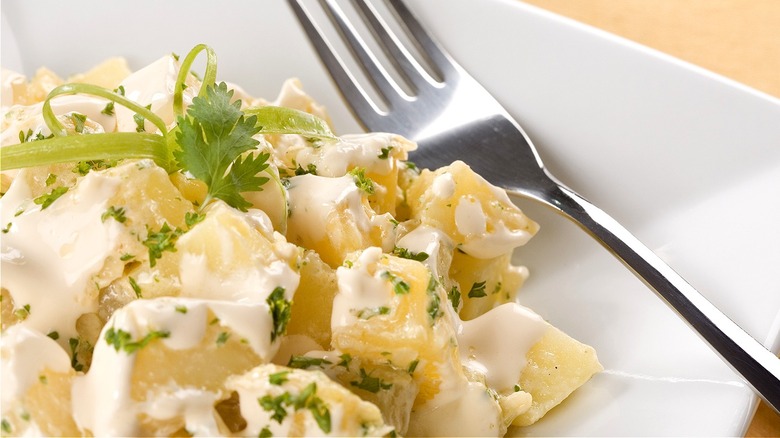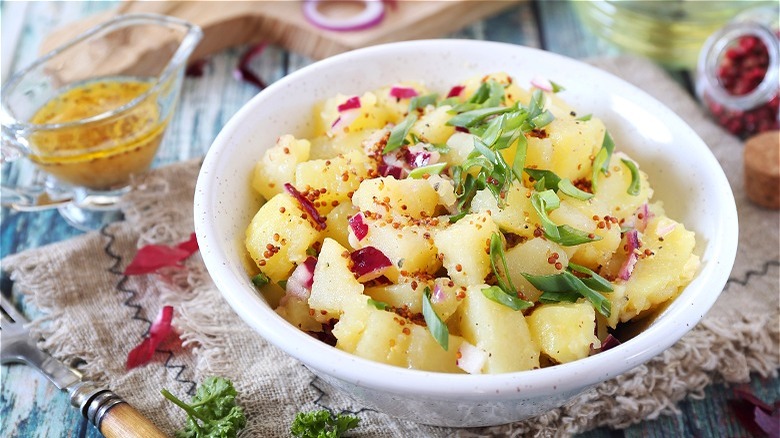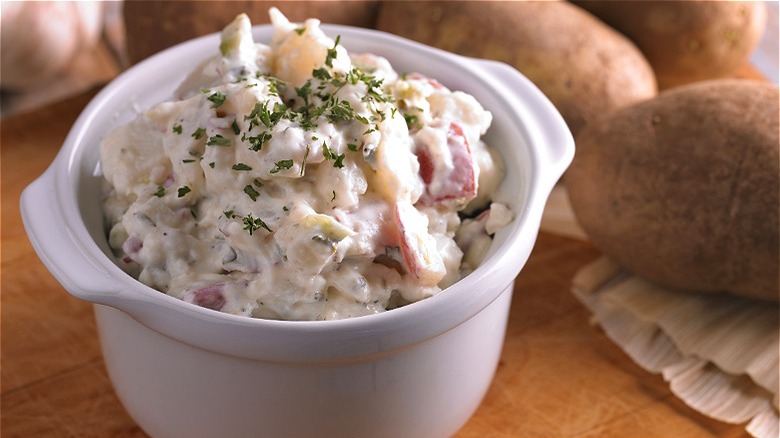Warm Potato Salad Is An Easy Spin On The Summer Classic
If you have a slew of cookouts to attend this summer, there's a strong chance you'll see a creamy homemade potato salad or two among the buffets of hot dogs, casseroles, and fun summer desserts. Most foodies are aware of how traditional potato salad is prepared: cooked potatoes, optional hard-boiled eggs, fresh chopped veggies like onion and celery, and a cream-based dressing consisting primarily of mayonnaise and mustard all mixed together to create one chilled summer side dish. Chances are most of you have enjoyed your past portions of potato salad nice and cold, yet how many of you have purposely enjoyed your potato salad warm?
When referring to warm potato salad, we're not talking about the forgotten kind that spent too much time in the sun. As it turns out, you can purposely make warm potato salad, and not only is it easy to make, but doing so may just be the unexpected twist your summer meals need. Surprisingly, there are many ways to make warm potato salad. You can keep things simple by heating up your traditional recipe in the oven or microwave, or you can get creative and follow a new recipe that calls for a designated amount of cook time. Before we get into why paying attention to your potatoes' internal temperature is important, let's get into the specifics of how to make your very own warm potato salad at home.
There are many ways to turn classic potato salad into a warm side dish
If you're up for trying warm potato salad, the good news is that you can transform your classic recipe into a warm meal accompaniment with just a few kitchen appliances. Take a cold portion of potato salad, place it on a microwave-safe plate, and cook on high for at least 90 seconds. Alternatively, you can transform an entire platter of potato salad in your oven. Simply transfer your standard potato salad to an oven-safe dish, and cook it in a 400-degree oven for at least 30 minutes.
If heating up cold potato salad doesn't sound appetizing, there are specific recipes you can follow that require a certain amount of cook time in your oven. You can follow a recipe similar to classic creamy scalloped potatoes: Add a bunch of cheese, cooked bacon, and mayonnaise to cooked potatoes in a casserole dish, and bake it until it's nice and bubbly.
You can also make a traditional German potato salad that combines cooked potatoes, fried bacon, onions, vinegar, and an array of seasonings, which can be enjoyed either hot or cold. Whichever way you decide to eat potato salad, just make sure to stay vigilant regarding the internal temperature of your cooked potatoes.
Why you should eat only hot or cold potato salad
While you research the best potato salad recipes perfect for cookouts, picnics, and more, you need to make sure your resulting dish doesn't end up sitting at room temperature for too long. Potatoes are a food that is ripe for bacterial growth if left at any temperature between 41 and 135 degrees Fahrenheit, according to Food Safety News. They are considered a time/temperature-control-for-safety food, meaning you could potentially make yourself sick if you don't monitor the amount of time your spuds are left out in this temperature range. Potatoes are on the more acidic side, so this increased acidity combined with the presence of protein and water can lead to bacterial growth if left in the right conditions.
Freshly cooked potatoes should be consumed or chilled within 2 hours of cooking. This same temperature rule applies to reheating. If you decide to upgrade that leftover potato salad currently chilling in your refrigerator, always make sure you reheat those refrigerated portions to at least 140 degrees to prevent the potential formation of bacteria. As long as you're keeping a watchful eye on the time and temperature of your spuds, there's no reason why you can't reheat your beloved potato salad to see if a slight temperature change truly makes a difference to how much you enjoy this summer staple.


